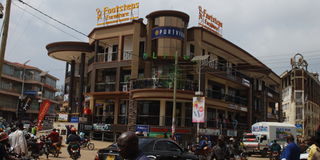Prime
How shortage of architects frustrates the housing sector

Some of the new structures erected in Mbarara City recently. PHOTO /RAJAB MUKOMBOZI.
What you need to know:
In 2018 the majority of districts and local government entities did not have architects. Only one had a registered architect and that was Kampala Capital City Authority (KCCA).
Mbarara is a city under construction there are visible signs of ongoing construction projects everywhere. This means that it is a busy period for the construction stakeholders and most especially architects whose services are vital before any project can take off. This has led to the growth of architect firms that can be found on every street. An architect is a professional who plans, designs and oversees construction of buildings.
But recently, during a stakeholder’s engagement on the roles of Architects Registration Board (ARB) held in Mbarara City, the board revealed that in the whole of the western region, there is only one recognised and registered architect, and that in the whole country there are only 270 registered architects.
Shocking shortage
“The country has only 270 qualified and registered architects but the law requires that every district and local government entity must have an architect. Shortage of architects is not good news to the housing sector,” explains Robert Kigundu, the ARB chairperson.
The above revelation casts more doubt on the future of the housing sector that continues to be marred by occurrences such as collapsing buildings that are sometimes fatal.
At the meeting attended by the Chief Administrative Officers, city/town clerks, planners and local government leaders, the executive secretary National Building Review Board (NBRB), Flavia Bwire, revealed that there is a big challenge in the housing sector due to significant shortage of architects and architectural firms in the country.
“Our findings have shown a shortage of architects and architectural firms in the country that has bred continuous use of unqualified personnel claiming to be architects,” noted Bwire.
The law
She added that the law stipulates that every district and local government entities such as cities and municipalities all over the country must have building committees and that on each of these committees there should be an architect.
“Section 28 of the Building Control Act is very clear on the need of an officer responsible for architecture on the building committee. Our mandate is to oversee, inspect and monitor operations of these committees, in our compliance audit exercises, we discovered the continued absence of architects who are supposed to take responsibility for architecture as of great concern,” said Bwire.
Kigundu added that for example their findings in 2018 indicated that the majority of districts did not have architects.
“In 2018 the majority of districts and local government entities did not have architects, only one had a registered architect and that was Kampala City Authority (KCCA) but the law requires that every district and local government entities have an architect,” added Kigundu.
Dilemma
Mbarara deputy city clerk Richard Mugisha noted that the housing sector remains in a dilemma due to lack of architects in the country.
“The country has more than 500 town councils, more than 100 districts, more than 30 municipal councils and 10 cities and all these should have building control committees that must have an architect on it but we have been told the country has only over 200 architects. Who has been authorising construction projects in these places if there are no architects?’’ Mugisha wondered.
Mbarara City Resident City Commissioner Col James Mwesigye said lack of architects in the country could be a reason why there are many quacks and explains the existence of substandard and collapsing buildings especially in towns.
“I now come to sympathise with developers who use quacks to draw their plans which are partly responsible for collapsing and substandard buildings. The government needs to do something if we are to have an organised housing sector in the region,” said Col Mwesigye.
He added, “Some cities such as Mbarara are developing at a terrific speed but if we are not careful we are going to follow the steps of Kampala that was messed up. People here just build the way they want. But we have engineers, planners and a full Architects Registration board. Why are you not taking charge of the situation?”
Col Mwesigye added that even the 270 registered architects are not given a chance to work in government entities because the structure for their recruitment is not provided for in local governments.
Way forward
Elly Muhwezi, Senior Secretary Bushenyi District said the Architects Registration Board should help them in lobbying the government in the recruitment of even these few architects.
“Our hands are tied, the law requires us to have architects but there is no funding to recruit them because we have wage issues. The ARB should influence government and public service to recruit these architects,” said Muhwezi.
Albert Tinamukama, the district planner revealed that he usually receives plans duly signed by architects from Mbarara City whom he thought were qualified architects.
“I always receive plans duly signed by at least five different architects from Mbarara but when you tell me there is only one registered and known architect in western region I get concerned about the service we are rendering. Despite the small number of architects, ARB should help us get rid of these quacks,” said Tinamukama.
Explaining the dearth of architects in Uganda, Kigundu said architecture is a relatively new course that was only recently introduced at institutions of learning.
“The course in architecture in the country started in 1989 but even then the completion rate is very low because it is a difficult course that is partly the reason we have a few professionals in architecture,” said Kigundu.
He, however, said despite the few architects these can be able to do work across the country on a rotational basis.
“If government recruits these, they can work on a rotational basis in districts and regions. Our appeal is that the government commits funds and public service puts the available architects on government employment structures,” Kigundu urged.
Internvetion
He added that they are the board is embarking on a countrywide audit to weed out the quack architects. The ARB has already opened an office in Mbarara city and promised to open other regional offices to strengthen responsibilities and roles of architects in the housing sector.
This will hopefully curb the incidents of buildings collapsing. For example on October 6, 2021 a three-storeyed building collapsed on Victor Bwana Road in Mbarara City.
Bwire attributed some of these accidents to lack of supervision and monitoring from professionals including architects.
“We are witnessing spontaneous development in Mbarara City but this must be supervised, monitored and regulated to avoid buildings accidents that have already,” said Bwire.
She said they are now carrying out dissemination meetings to raise public awareness on the role of using professionals like architects, surveyors and engineers in ensuring building standards as a remedy to building accidents.
Kigundu said the roles of architects include promoting the health of the buildings, occupants, and reducing negative effects in the construction process on the environment. He added that architects are trained to preserve, improve and create quality building environments for sustainable development.
Statistics
Information from the Ministry of Local Government indicates that the country has one capital city, 135 districts,10 cities,31 municipalities,580 town councils and all these must have building committees with an architect on it in accordance with section 28 Building Control Act 2013.
The above statistics mean the country has 757 districts plus local government entities that need an architect each. This number minus 270 registered architects according to ARB means the country is short of 487 architects.




